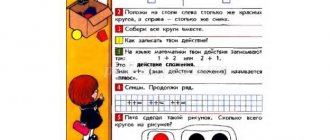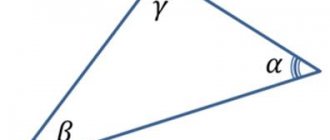Math lesson, 4th grade. Finding the unknown term
Development of a mathematics lesson for 4th grade.
Finding the unknown term. An equation of the form x+15=68:2 A lesson plan in mathematics has been developed for 4th grade students to help primary school teachers. Author: Elena Sergeevna Sukhoruchenko, State Institution of the LPR “LOUSOSH No. 25 named after M.S. Likhavid" Lesson topic: Finding the unknown term. Equation of the form x+15=68:2 Goals: to familiarize students with a complex equation, teach them to find unknown terms in complex equations, improve computational skills, problem-solving skills, develop attention, memory, logical thinking, and cultivate interest in mathematics. Tasks: - Organizing joint work of students and teachers. — Involving students in basic mental operations, analysis, updating and systematization of acquired knowledge. — Development of logical and creative thinking. — Formation of the ability to work in a group. Equipment: textbook, map, boat, tables, algorithm for solving equations Type of lesson: learning new material
Lesson progress
1. Org. moment And the country of mathematics is beautiful and strong Equations and problems Mental arithmetic is here every time. I wish you good luck for your good work (- Guys, did you have any difficulties completing your homework) 2. Motivation and updating of basic knowledge Today we have an unusual lesson. This lesson is an adventure, a sea voyage to treasure island. The journey is long and interesting. Various obstacles await you along the way. The knowledge and skills that you acquired in mathematics lessons and that you will acquire today will help you with this. During the trip you will make notes in your logbooks (workbooks). And at the end of the lesson we will try to find the treasure. So, we set sail. - Tell us what we need to take on the road so as not to get lost along the way. — What do sailors, archaeologists, geographers take with them on a trip? (map). Since you and I are on a sea voyage, we will set off on a ship. 1) work in a notebook - First, let's open our on-board notebooks, mark the coordinates by doing a calligraphy minute - Let's write down the departure date (date and class work) I suggest you decipher the name of our ship. Write down the results of the cipher in your notebook. 99*1= 99 1500:100=15 11*6=66 88:2=44 50*10=500 32*8=256 Now decipher the name using this table. (post on the board) 99 15 66 44 500 256 knowledge - Well done! We did it. Our ship will be called “Knowledge” 2) The bay is the departure point of the ship. — We are leaving from the bay. (What is a bay?) A small sea bay suitable for mooring ships. — Let's check the team's readiness by answering questions. —What are the numbers called when adding? (Term, term, sum). — How to find an unknown term? (Subtract the known term from the sum) • The first term is 50, the second is 4. Find the sum and you will find out how many seas there are on our planet (54). • 1st term 6000, sum 6009. Find the second unknown term and you will find out how many uninhabited islands there are on our planet 6009- 6000=9 (about 9, although the exact figure is unknown). - Well done! Let's set sail! 3. Communicating the theme and objectives of the lesson Shark Island - Our first obstacle is called Shark Island. (move the boat) Did you know...that there are 170 species of sharks. Some of them are dangerous and some are harmless. For example, sharks, which often follow ships, pick up leftover food from ships. Even small fish are not afraid of these sharks. Of the large sharks, whale sharks are not dangerous if you do not attack them. But the most terrible is the giant white shark, its length reaches 12 meters. She is definitely dangerous. Let's see what the task is on this island. (Rebus in the teeth of a shark) Post on the board - Work in pairs. Decipher the rebus. Children call the topic of the lesson “Equation” - What do we know about the equation? (Expression with an unknown component) Today we will get acquainted with a new type of equation and learn how to solve them 4. Self-determination for the activity Island “Secret Chest”. — Guys, we sailed to the island “Secret Chest”. What secret does this island hide? (point to closed equation) Let's figure it out. a) Conversation. what is an equation, what does it mean to solve an equation……. There is a note on the board (close the equation on the right) X +37=64 X + 12=48:2 - What is written on the board? /equation/ What is an equation?/ An expression with an unknown component/ What does it mean to solve an equation?/ Find the value of a variable or the root/ Poem When you solve an equation, my friend, You must find its root The meaning of a letter is not difficult to check Put it in the equation carefully If the equation is correct If it works out for you, then immediately call the root the meaning. What is the unknown component in the equation? /Unknown component term/ -How to find a term?/Subtract the known term from the sum/ Solve the equation (write in a notebook, 1 person at the board) X +37=64 X= 64-37 X= 27 27+37=64 64=64 -What secret is kept in the chest? Let's get a look. Open equation. -What is the difference between the equations?/right side/ - We will get to know how to act when solving the second equation during the lesson b) Physical education - Guys, today we are sailors, and all sailors are strong, brave, seasoned, and in order for us to become like that, let's Let's do some exercises. We stood up straight, stretched And smiled at each other Two claps above our heads Two claps in front of ourselves We hit our knees with our palms We jump on the right leg And on the left we certainly jump at the same time 4. Work on the topic of the lesson Monkey Island - Guys, while we were resting we didn’t notice how our the ship sailed to the island of monkeys. Monkeys greet us and ask us to help complete the tasks in the textbook. Working with the textbook Open the textbook on page 62 No. 276 A) No. 276 p.62 / orally / - Fill out the table using the rule for finding the unknown term. (On the chain) B) Familiarization with the equation on p. 62 (near the red line) Consider equation x+15=68: 2 - Is this a simple equation or a complex one? Let's create an algorithm for solving the equation / post it on the board // 1. Read the equation / The sum of the numbers x and 15 is equal to the quotient of the numbers 68 and 2/ 2. Calculate the value of the expression on the right side / 68: 2/ 3. Write the simple equation /x+15 =34 4. Find the unknown component / x=34-15, x=19 5. Check / 19+15=68:2 34=34 Solving the equation from the tablet in the notebook according to the algorithm./ 1 student at the board, the rest write in notebooks./ X + 12=48:2 X+12=24 X=24-12 X=12 12+12=48:2 24=24 C) Exercise for the eyes “Guys, help! On the island, monkeys got tangled in vines. Let's unravel them and do exercises for the eyes 5. Reinforcing the studied material Pirate Island Our ship sailed to the pirate island so that the pirates do not notice us, we need to complete the task Working with the textbook / continued / A) No. 277 p. 62 / 1 student at the blackboard / Select a complex equation of two and solve using the algorithm x+78=97+3 x+78=100 x= 100-78 x=22 22+78=97+3 100=100 B) exercise for posture “Tree” Raise your arms up , imagine a strong tree, reach for the sun, straighten the backs. C) Guys, there is a message in a bottle on the island - the text of the problem. A dolphin swam 4000 m in 1 hour, 360 m less in the second hour than in the 1st hour, and 2640 m less in the third hour than in the 1st and 2nd hours together. How many meters did the dolphin swim in the third hour? (The teacher writes down the conditions, and the students write down the actions)
-We have safely passed the pirate island.
6. Reflection. Summing up - Guys, what did you manage during the travel lesson? -What turned out to be difficult? -What do you think is the main treasure that helped you in the lesson? (our knowledge) Praise (Put your right hand on your head, stroke it and say: “Oh, what a great fellow I am!” And now praise your neighbor: “Well done”) 8. Assessment During the lesson they worked well...,... because they answered orally, solved equations and problems. 8.D/z To reinforce the topic of the lesson, let’s write down the house.
task No. 281, No. 282 (p. 62) Download Development of a lesson in mathematics for grade 4
We recommend watching:
Math lesson in 4th grade Math lesson notes - 4th grade UMK "School 2100" Math lesson notes in 4th grade at a correctional school. Written subtraction Summary of a mathematics lesson in the 4th grade of a correctional school. Increase in number several times
Similar articles:
Travel lesson in mathematics in 4th grade
Problems to find the unknown third term
- Hello guys! It's great that we're together again. We haven't seen each other for so long! Today I want to introduce you to problems to find the unknown third term. I can already see your surprised faces. Why not Plus, but I, Minus, introduce you to problems in which you need to find a term? Just a moment of patience. Soon you will understand everything. So let's get started.
I present to your attention this task:
28 tulips bloomed in our flowerbed near the queen’s palace. Of these, 12 are red, 6 are pink, and the rest are yellow. How many yellow tulips bloomed in the flowerbed?
Let's draw a schematic diagram for this problem. So, in this problem we know the total number of tulips - there are 28 of them. Let's denote them with a segment. There are 12 red tulips. The red ones are part of the total number of tulips, therefore the segment that represents them is part of the first segment. There are 6 pink tulips. And this is also part of all tulips. But the segment that remains are yellow tulips.
So, you see that the total number of tulips is the sum of three parts, that is, terms, two of which are known, and the third is unknown. What do you think should be done to find the unknown term? Do you remember?
To find the unknown term, you need to subtract the known term from the sum.
And we have two known terms. So we'll subtract them. Let's write down:
Answer: 10 yellow tulips bloomed in a flowerbed.
And the solution to this problem can be written in the form of a single numerical expression:
Answer: 10 yellow tulips.
Well, you understand why I, Minus, explain the problems of finding the third term.
Do you think that's all? Do you know everything? Or maybe someone savvy has already guessed how this problem can be solved in another way?
But, nevertheless, I will tell you how this can be solved. We can first find out how many red and pink tulips there are together, that is:
This is part of all tulips. And now you can find out the unknown part, that is, the number of yellow tulips. We get:
Answer: 10 yellow tulips.
Compare two different ways of solving the same problem. The methods are different, but the answer is the same.
Do you think this solution can be written in a numerical expression?
Well, of course you can. We just need to remember - we need to find the unknown third term. And to find the unknown term, you need to subtract the known term from the sum.
The sum is the total number of tulips. Therefore, we subtract from the total... guessed it? Of course, the sum of the numbers 12 and 6. Don't forget to put this sum in brackets. If you forget, it turns out that you will not subtract the entire amount, but only the number twelve. And 6, on the contrary, will be added. Well, I told you so, just in case. I think that among you there are no such forgetful people.
Answer: 10 yellow tulips.
Well, you understand how to solve problems to find the unknown third term. That is, when the total amount of something and two parts are known, and the third must be found.
You can subtract each of the known parts from the sum in turn:
Or you can do this:
1) Find the sum of the known terms:
2) Subtract the amount received from the total amount:
Answer: 10 yellow tulips.
And now I suggest you solve this problem yourself. And then we will check if you solved it correctly.
Plus I went mushroom picking and picked up 36 mushrooms. Of these, 14 are boletus, 7 boletus, and the rest are chanterelles. How many chanterelles did Plus collect?
Let me help you a little - I’ll draw a schematic drawing:
Now check it out.
1 way:
Answer: 15 chanterelles.
Method 2:
Answer: 15 chanterelles.
Any of the solutions given here is correct. So, if you solved the problem this way and got 15 chanterelles in your answer, then our lesson was useful. And I can go for a walk. But before I go, I want to remind you again.
When solving problems to find the unknown third term, draw yourself a schematic drawing. By drawing it, you will read the problem statement more carefully. The drawing will help you choose the right solution.
Well, goodbye guys. I'll go and admire the tulips in our garden.



